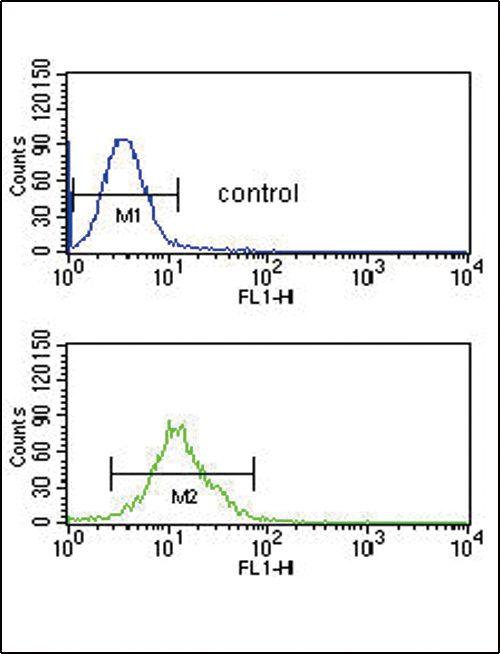SMYD3 Antibody (N-term)
Purified Rabbit Polyclonal Antibody (Pab)
- SPECIFICATION
- CITATIONS: 1
- PROTOCOLS
- BACKGROUND

Application
| FC, IHC-P, WB, E |
|---|---|
| Primary Accession | Q9H7B4 |
| Reactivity | Human |
| Host | Rabbit |
| Clonality | Polyclonal |
| Isotype | Rabbit IgG |
| Calculated MW | 49097 Da |
| Antigen Region | 7-35 aa |
| Gene ID | 64754 |
|---|---|
| Other Names | Histone-lysine N-methyltransferase SMYD3, SET and MYND domain-containing protein 3, Zinc finger MYND domain-containing protein 1, SMYD3, ZMYND1, ZNFN3A1 |
| Target/Specificity | This SMYD3 antibody is generated from rabbits immunized with a KLH conjugated synthetic peptide between 7-35 amino acids from the N-terminal region of human SMYD3. |
| Dilution | FC~~1:10~50 IHC-P~~1:10~50 WB~~1:1000 E~~Use at an assay dependent concentration. |
| Format | Purified polyclonal antibody supplied in PBS with 0.09% (W/V) sodium azide. This antibody is prepared by Saturated Ammonium Sulfate (SAS) precipitation followed by dialysis against PBS. |
| Storage | Maintain refrigerated at 2-8°C for up to 2 weeks. For long term storage store at -20°C in small aliquots to prevent freeze-thaw cycles. |
| Precautions | SMYD3 Antibody (N-term) is for research use only and not for use in diagnostic or therapeutic procedures. |
| Name | SMYD3 |
|---|---|
| Synonyms | ZMYND1, ZNFN3A1 |
| Function | Histone methyltransferase. Specifically methylates 'Lys-4' of histone H3, inducing di- and tri-methylation, but not monomethylation (PubMed:15235609, PubMed:22419068). Also methylates 'Lys-5' of histone H4 (PubMed:22419068). Plays an important role in transcriptional activation as a member of an RNA polymerase complex (PubMed:15235609). Binds DNA containing 5'-CCCTCC-3' or 5'-GAGGGG-3' sequences (PubMed:15235609). |
| Cellular Location | Cytoplasm. Nucleus. Note=Mainly cytoplasmic when cells are arrested at G0/G1. Accumulates in the nucleus at S phase and G2/M. |
| Tissue Location | Expressed in skeletal muscles and testis. Overexpressed in a majority of colorectal and hepatocellular carcinomas. |

Provided below are standard protocols that you may find useful for product applications.
Background
SMYD3 is a histone methyltransferase that plays a role in transcriptional regulation as a member of an RNA polymerase complex.
References
Zou,J.N., Wang,S.Z. Cancer Lett. 280 (1), 78-85 (2009)
Wang,S.Z., Luo,X.G. BMB Rep 41 (4), 294-299 (2008)
Wang,H., Liu,Y. Cancer Sci. 99 (4), 787-791 (2008)
Barlesi,F., Giaccone,G. Int. J. Cancer 122 (6), 1441-1442 (2008)
Hamamoto,R., Silva,F.P. Cancer Sci. 97 (2), 113-118 (2006)
If you have used an Abcepta product and would like to share how it has performed, please click on the "Submit Review" button and provide the requested information. Our staff will examine and post your review and contact you if needed.
If you have any additional inquiries please email technical services at tech@abcepta.com.














 Foundational characteristics of cancer include proliferation, angiogenesis, migration, evasion of apoptosis, and cellular immortality. Find key markers for these cellular processes and antibodies to detect them.
Foundational characteristics of cancer include proliferation, angiogenesis, migration, evasion of apoptosis, and cellular immortality. Find key markers for these cellular processes and antibodies to detect them. The SUMOplot™ Analysis Program predicts and scores sumoylation sites in your protein. SUMOylation is a post-translational modification involved in various cellular processes, such as nuclear-cytosolic transport, transcriptional regulation, apoptosis, protein stability, response to stress, and progression through the cell cycle.
The SUMOplot™ Analysis Program predicts and scores sumoylation sites in your protein. SUMOylation is a post-translational modification involved in various cellular processes, such as nuclear-cytosolic transport, transcriptional regulation, apoptosis, protein stability, response to stress, and progression through the cell cycle. The Autophagy Receptor Motif Plotter predicts and scores autophagy receptor binding sites in your protein. Identifying proteins connected to this pathway is critical to understanding the role of autophagy in physiological as well as pathological processes such as development, differentiation, neurodegenerative diseases, stress, infection, and cancer.
The Autophagy Receptor Motif Plotter predicts and scores autophagy receptor binding sites in your protein. Identifying proteins connected to this pathway is critical to understanding the role of autophagy in physiological as well as pathological processes such as development, differentiation, neurodegenerative diseases, stress, infection, and cancer.



